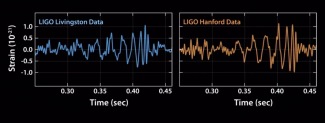It’s been a year since researchers with the Laser Interferometer Gravitational-wave Observatory (LIGO) announced the first direct observations of gravitational waves, the oscillations in the fabric of space and time created by powerful cosmic events—like the merging of two massive black holes. This cosmic phenomenon was first predicted by Einstein in 1915, but it took a century for technology to become capable of detecting it. On Sept. 14, 2015, the twin LIGO observatories in Louisiana and Washington state both registered an oh-so-subtle shake that came from far outside our planet…1.3 billion light-years away, in fact.

The signal—the now-famous “chirp”—was a vibration of LIGO’s super-sensitive instruments caused by a run-in with a ripple in space-time, spreading outwards across the Universe from the combining of two stellar-mass black holes. But before scientists could make that historic confirmation, they first had to prove to themselves that what was detected was actually real and not the result of something terrestrial, accidental, or even malicious. With their scientific reputations at stake they couldn’t afford to globally announce a false positive, and how they confirmed their discovery is almost as fascinating a story as the discovery itself.
Documentary filmmaker Kai Staats has made the LIGO story into a short film, showcasing the various team members and how they felt on the day the signal was picked up, and what needed to happen to rule out any other possible explanations. The result is a fascinating insight into the scientific process at work, which fortunately in this case had a very happy ending.
Watch the film in its entirety above, and read more about the 2016 LIGO announcement here.
HT to Rachelle Williams for the tweet about the video.
Reblogged this on brengunzzz.
LikeLike